With a better understanding of advertising attribution, it will become easier to pinpoint which of your PPC campaigns, keywords and ads are having the most significant impact on your conversions and sales.
The most effective way to secure more budget is by proving that your PPC campaigns are generating more money than they’re spending.
While this may sound obvious, the process of connecting marketing with revenue is complex for many marketers.
In fact, we found that 1 in 3 marketers find proving ROI to be one of their biggest challenges.
So, what’s the solution?
The answer lies in advertising attribution.
For this article, we’ll discuss:
Without further ado, let’s jump in.
💡 Pro Tip
Ruler makes the process of ad attribution much easier. It tracks data on a visitor level, allowing you to successfully attribute leads and marketing-generated revenue across multiple campaigns, ads, keywords and more.
How Ruler attributes revenue to your advertising
In its most basic form, advertising attribution, or marketing attribution, is a set of rules that determines how your ad account applies credit for clicks, conversions, and sales.
The outcome of advertising attribution is to provide you with insight into what keywords, ads, and campaigns are generating the most leads and revenue for your business.
First, we’re going to show you how to choose your attribution model in Google Ads. Then, we’ll walk you through each attribution model, and discuss their pros, cons and when they’re most effective.
1. At the top click “Tools“, then under “Measurement”, select “Attribution“.

2. On the left, click “Model Comparison“.

3. Click “Campaign” to select one of the following: “Campaign, Ad group or Keyword“. Navigate to “Last click” to compare: Last click, First click, Linear, Time decay or Position-based.

4. Navigate the drop-down menus to select your desired attribution models. Alternatively, you can type in specific keywords, ad groups or campaigns in the search box.
Without an attribution model, it would be impossible to determine which ad campaigns are most and least successful—and if running ads is even worth the cost.
Related: What is attribution modelling and why does it matter?
Here’s the bad news, there’s not a one-size attribution model for all businesses and campaigns.
Now, for the good news.
Below, we’ve listed the six attribution models available in Google Ads, how they work, as well as how you can choose the right one for your campaign by comparing their pros and cons.
With the last-click attribution model, all conversions are allocated to the last search ad that a user engaged with before converting.
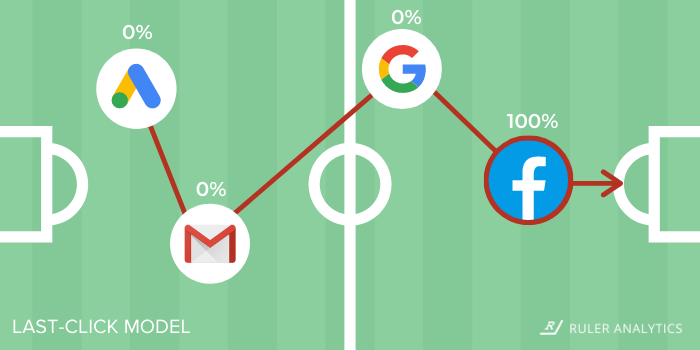
Related: Marketers guide to last-click attribution
Pros: Easy to implement and understand. Allows you to analyse the final touchpoints of your customer buying cycle.
Cons: Oversimplified. It neglects all of the other marketing touchpoints in the customer journey that helped influence a conversion or sale, and it doesn’t reflect real-world decisions made over multiple channels.
Most effective: Businesses with shorter sales cycles. Marketers who want to track which campaigns are most effective at converting anonymous visitors into leads or sales.
With the first click attribution model, all conversions and credit are allocated to the first search ad that a user engaged with before converting.
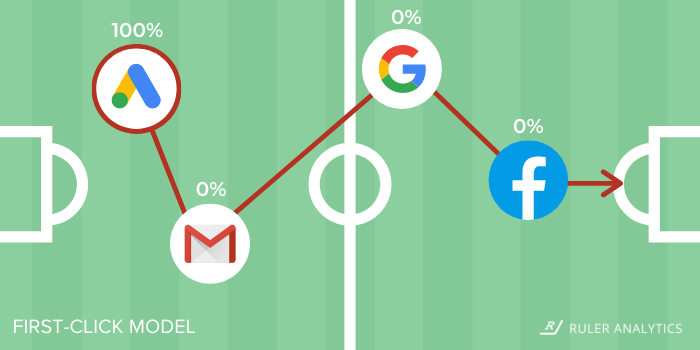
Related: A complete guide to first-click attribution
Pros: Easy to understand and implement. Allows you to track how people are discovering your products and services.
Cons: It doesn’t consider all of the other touchpoints a customer interacted with throughout their journey.
Most effective: If your advertising is limited to two channels or less. Measuring brand awareness. Uncover which channels are driving new customer acquisition.
With the linear attribution model, the credit is allocated evenly across all of the touchpoints in the buyer’s journey.

Pros: Ideal if you want to measure the overall performance of your advertising campaigns.
Cons: When all the channels receive equal credit, it can be difficult to determine which campaigns are contributing the most value.
Most effective: For long-term marketing measurement. Ideal if you drive conversions from all numerous channels, as eventually, you’ll identify the specific marketing channels that contribute the most value.
With the time decay attribution model, credit is distributed to all marketing touchpoints, but the later touchpoints receive a higher percentage of credit than the earlier ones.

Pros: Shows you which of your campaigns do the best job of generating conversions.
Cons: Like linear, Time Decay can potentially provide too much (or too little) value to a specific touchpoint.
Most effective: Suitable for businesses that rely on repeat purchases or conversions.
Position-based attribution tracks every single touchpoint but will assign 40% to first and last-click touchpoints. The remaining 20% is divided evenly among the other touchpoints.
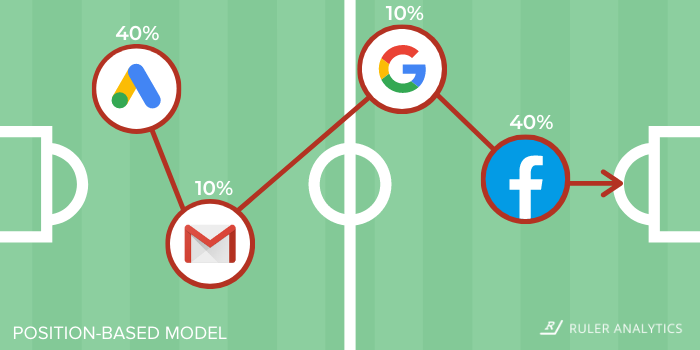
Pros: Shows you which touchpoints are effective at driving new customers and which channels are most reliant at converting visitors into leads or sales.
Cons: Not time-efficient, and treats all touchpoints in the middle as equal. In most cases, some touchpoints are deemed more crucial than others.
Most effective: Suitable for businesses that rely on repeat purchases or conversions.
Data-driven attribution uses actual data from your Analytics account to create a custom model for assigning conversion credit to marketing touchpoints throughout the entire customer journey.
Related: Marketer’s guide to data-driven attribution
Pros: Chooses your attribution model best on intelligence, without any guesswork. Ability to optimise bidding best on unique performance data.
Cons: You need a minimum 15,000 clicks and 600 conversions in the last 30 days to qualify for this attribution model. To continue using data-driven attribution, you also need to sustain at least 10,000 clicks and conversions for each consecutive 30 days.
Most effective: Suitable for businesses that meet the required threshold above. Spending more than £10,000+ per month on Google Ads.
By understanding the common mistakes PPC marketers make, you can help prevent misaligned data and increase your chances of revenue success. Let’s take a look at the most common ad attribution pitfalls.
One of the biggest mistakes PPC marketers make is that they don’t consider offline contributions such as phone call enquiries.
Sure, Google Ads has a feature that allows you to track which campaigns made the telephone ring, but counting call conversions provides you with very little insight into the success of your marketing effectiveness.
Related: Optimising your Google Ads campaigns with offline conversion tracking
Paid advertising, in particular, has a reputation for driving customer support calls and cold callers with something to sell.
In short, counting all calls as conversions can lead you to the wrong conclusions about the performance of your PPC campaigns, which can negatively impact your bottom line.
But, with no way of linking telephone leads back to their source, PPC marketers have had great trouble calculating the ROI of their PPC activity, as they haven’t been able to prove which offline conversions generated by their paid ads led to a sale.
Related: How to measure the ROI of your PPC
💡 Pro Tip
Go beyond call conversions and identify which marketing sources drive the most revenue and long-term value with our free guide on offline conversion tracking.
A complete guide to offline conversion and phone call tracking
Data-driven marketing that uses a single attribution model is a flawed approach in today’s marketing landscape.
Related: A complete guide to data-driven marketing and how to get started
Deciding where to increase or decrease resources based on last-click or first click in isolation can have a devastating impact on your profitability.
Below are two screenshots of the Ruler dashboard. They both contain data from the same account and have been set the same date range.
First Click

Last Click

The only difference is that the first screenshot is assigning revenue using the first-click attribution model (first-click attribution model assigns 100% credit to the initial touchpoint).
The second screenshot is attributing revenue using the last-click model.
When you compare both screenshots, you can see a clear difference in revenue for both models.
Email works better near the top of the funnel, whereas Google Paid plays a bigger part near the bottom.
If you were relying on a single-touch attribution model, then you wouldn’t have this level of insight.
For a long time, PPC marketers have measured the effectiveness of their campaigns and channels by counting the number of conversions in tools like Google Ads.
Now, before we go any further, we’re not saying the process of tracking conversions is “wrong”.
But tracking conversions in isolation doesn’t guarantee long-term value.
You can have all the conversions in the world, but that means nothing if your bottom line remains flat.
Google Ads treats your leads as a data point and doesn’t provide any information on whether or not your conversions turn into sales.
But, by combining your Google Ads campaigns with ad attribution software, you can gain access to actionable data that will allow you to track which campaigns are generating the most value for your business.
And, more importantly, optimise your campaigns for better results, both online and offline.
Let’s not waste anymore time and dive into our recommended ad attribution tools and software.
Ruler Analytics is a marketing attribution tool that tracks each anonymous visitor over multiple sessions, traffic source, keywords and more.
Related: How to view full customer journey with Ruler
When an individual converts via a phone call, form or live chat, Ruler matches the real user details to the marketing touchpoints.
Ruler works with 1000+ products and can send this data into your Google Analytics, CRM and other existing platforms, allowing you to get a bigger picture of your sales pipeline.
When a sale is closed into revenue Ruler will pass this data to your Google Ads account so that you can report on actual revenue generated.
Related: How Ruler attributes revenue to your marketing
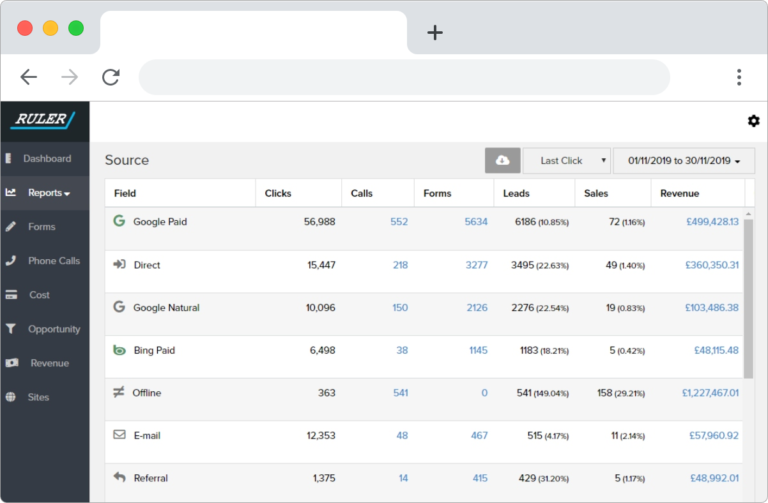
Pricing for Ruler starts at £199 a month and it has various plans to suit your specific needs. You can save 20% by paying annually and there are special rates for agency partners.
💡 Pro Tip
Want more information on Ruler and the services we offer? Grab our comprehensive guide on how Ruler works and see how it can boost the quality of your marketing measurement.
Why you need Ruler Analytics
Adinton measures your marketing spend, clicks, and conversions, and then predicts the effectiveness of each channel and provides information on whether you are under or over-investing.
Once the data is collected, Adinton allows you to manage online marketing investment return and sales with spending optimisation.
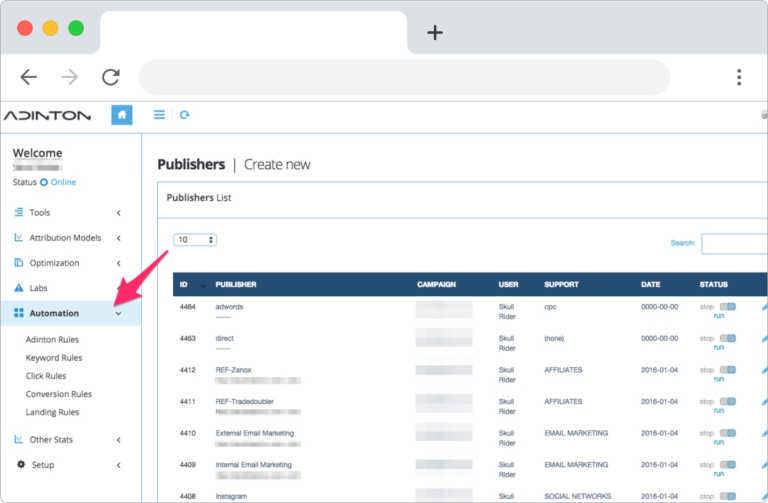
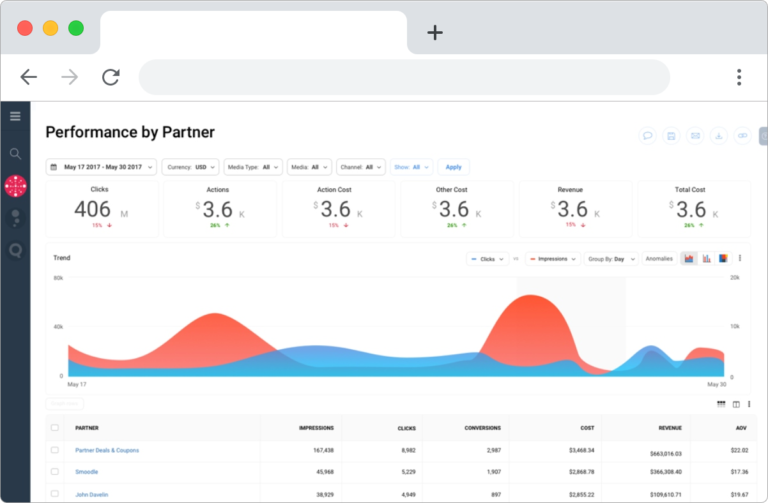
Altitude provides a full range of capabilities, including product-level attribution and multi-funnel conversion reports.
PPC marketers can also design their own attribution model to meet their business goals and objectives. You have the option to choose between static, dynamic or rule-based attribution.

Funnel.io is a data collection tool that turns marketing and advertising data into automated reports to help you make smarter decisions about your budgets and targeting.

Neustar allows marketers to fully understand their customer journey, both online and offline, to identify what impact their omnichannel campaigns are having on conversions.
If you want more options, then check out our recommended marketing attribution software and tools.
To maximise your performance, it’s important that you understand which areas of your marketing are driving the most value for your business.
With ad attribution software, you can understand how your customers search for your products and services, and what they do before they submit their interest.
You can see which ads, keywords and campaigns are generating the most revenue, how they relate to overall marketing ROI, and generate key insights to help leverage performance and increase profitability.
Want more information about Ruler? Download the guide on how Ruler works or book a demo and see it in action for yourself.

This article was originally published in October 2020 and last updated on the 25th April 2022 for freshness.